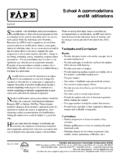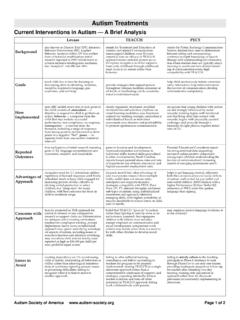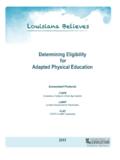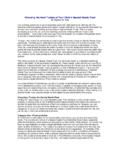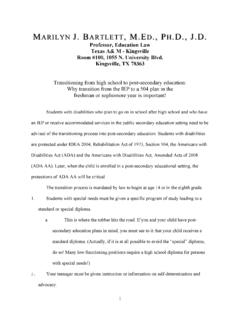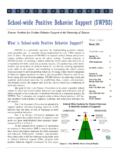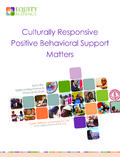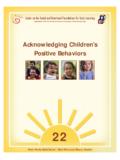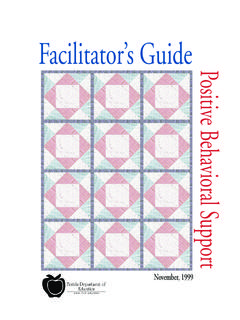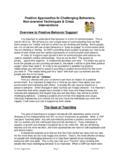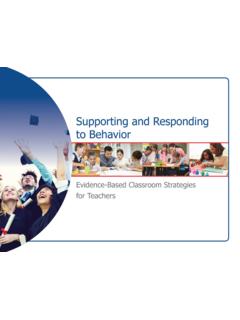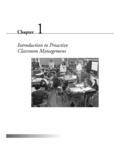Transcription of Functional Behavioral Assessment and Positive ...
1 Families and Advocates Partnership for Education (FAPE)FAPE Coordinating Office: PACER Center, Inc. 8161 Normandale Blvd., Minneapolis, MN 55437952-838-9000 voice ~ 952-838-0190 TTY ~ 952-838-0199 fax ~ 1-888-248-0822 toll-freeWeb site: ~ E-mail: are encouraged to copy and share this information, but please credit PACER children have inappropriate behaviors that arepart of their disability. These behaviors may make itdifficult to learn, cause harm to the child or others, orisolate a child from his or her peers. Some childrenhave behaviors that they can t control, such as tics fora child with Tourette syndrome or self-harmingbehaviors for some children with developmentaldisabilities. Some children may be sad or simply have not learned Positive ways to havetheir needs met. In any of these instances, the behav-iors interfere with the children s ability to learn theskills they need to be can teach appropriate behavior skills to children!
2 To do so, we need to understand problem behaviors,such as where they occur and what purpose they servefor a child. The process of learning about how chil-dren develop problem behaviors is called functionalbehavioral Assessment (FBA). If we learn about thebehaviors and know when and where they are likelyto happen, we can plan Positive strategies to teachnew behaviors. These strategies are called positivebehavioral interventions. Teachers and parents willuse the information from an FBA to help a child learnnew skills. The goal is to teach children how tomanage their own overview will help parents understand functionalbehavioral Assessment and Positive interventions. Youhave a very important role in this Assessment , becauseyou have information about your child that no oneelse has. When you understand the process, you canwork effectively with the rest of the team. You willhave the tools to make decisions when functionalbehavioral Assessment is proposed for your you know about your child will be used to helpdevelop effective by Dixie JordanThinking about behaviorAdults often have two different approaches to dealingwith problem behaviors.
3 These different approachesare based on different beliefs. One belief is that thechild is a problem, and the other is that the child hasa child is a problemBilly is a 12-year-old sixth-grade student. He refusesto do his schoolwork, and then his teacher does notknow what to do. He becomes angry when the teacherreminds him to get to work. He screams, swears, andeven throws his work on the floor so the teacher willleave him alone. The teacher may think Billy is lazy,mean, or disrespectful. The teacher may feel angryor threatened. Adults who are angry often use punish-ment or threats: Do it or else. We do not alwaysrealize that children do not think about their problembehaviors the way we we punish often, children may see us as un-caring. Some may come to fear or avoid us. Othersmay become even louder and angrier because of thepunishment. Children who do not back down whenarguing with adults often receive increasingly harshpunishments.
4 Many adults think children should notbe permitted to win disagreements. Children, on theother hand, often say things they do not really meanbecause they are angry. They may refuse to give upeven if they lose privileges or are suspended a child is suspended from school for problembehaviors, some people think of it as good medicinefor bad behavior . They think the removal teaches thechild a lesson and that the child will change theproblem behaviors as a Behavioral Assessmentand Positive Interventions:What Parents Need to KnowFamilies and Advocates Partnership for Education (FAPE) Positive Behavioral interventions are used beforeproblem behaviors occur. To develop Positive inter-ventions, the team must understand why a child hasproblem behaviors and what strategies might behelpful. Many different strategies can be used toreduce problem behaviors in school: changing wherea child sits in the classroom, adjusting the school-work, rewarding the child for Positive behaviors.
5 Thechild s teacher may speak in a different tone of voiceto help the child remain calm. Adults may try to keepcalm when the child is angry. The goal is to stop orreduce the problem behaviors so that punishmentdoes not become is an example: The teacher knows that Mary ismore likely to argue with the teacher when she sitsnext to Mark. If the teacher thinks Mary arguesbecause she wants Mark to notice her, there areseveral things the teacher can do. She can separateMary and Mark so that Mary does not try so hard toget his attention. She can also teach Mary morepositive ways to gain Mark s attention and providepositive reinforcement for using the new are governed by theirconsequencesJohn has a fight ( behavior ) and is suspended fromschool (consequence). If John loves school and cancontrol the behavior , the consequence is negativebecause he has to give up something he wants(school). If John dislikes school, however, he may seethat same consequence as Positive .
6 He may learn thatfighting is a good way to be sent home. The next timeJohn does not want to be in school, what behavior ishe likely to use? Many of us have learned to deal with problembehaviors by doing nothing until they occur. After achild uses the behaviors, we punish. Punishment doesnot teach new skills, though. Its goal is to stop prob-lem behaviors from continuing. If we do not teach achild what to do instead, the child will probablycontinue to misbehave. Any time a child uses abehavior that is successful in meeting a need, theBut what if that child does not like going to school?He or she may learn that using problem behaviors isa good way to earn a vacation from school. The childmay actually want what we think is a child has a problemBilly, the 12-year-old described earlier, has behaviorsthat need to change. Let s assume we have assessmentdata that give a clearer picture of Billy. We find thathe reads at a second-grade level.
7 He was sexuallyabused at age three by a neighbor. Billy is angry overhis parents recent divorce and continuing custodybattle. He is worried about where he will Billy s problem behaviors must change. Theyare serious and interfere with learning. What wedecide to do about the behavior , however, comesfrom how we feel about it and whether we believe itis willful. That is where Functional Behavioral assess-ment comes in. It can help us to identify why Billy isfrustrated and angry, so we can help him to learn theskills he needs. A reasonable person would have ahard time believing that punishment alone could helpBilly Behavioral InterventionsPositive: characterized by or displaying approval,acceptance, or : what we : an action that changes a courseof events.(Adapted from Merriam Webster s Tenth CollegiateDictionary.)The 1997 Individuals with DisabilitiesEducation Act (IDEA) regulations state:The IEP team shall, in the case of a child whosebehavior impedes his or her learning or that of others,consider, where appropriate, strategies, includingpositive Behavioral interventions, strategies, andsupports that address that (2)(i) Functional Behavioral Assessment - 2 Families and Advocates Partnership for Education (FAPE) behavior is likely to be repeated.
8 The behavior servesa function for the people agree that we need to have consequencesfor problem behaviors. We must also focus on teach-ing the Positive behavior skills we would like to we can understand the function of problem behav-iors, we can teach a child more Positive behaviorsthat serve the same function, and the problem behav-iors are no longer is Functional behavioralassessment? Functional Behavioral Assessment (FBA) is a processfor collecting information. The data the team collectsare used to help determine why problem behaviorsoccur. The data will also help identify ways to addressthe behaviors. Functional Behavioral Assessment dataare used to develop a Positive Behavioral interventionplan. The Individuals with Disabilities Education Actspecifically requires an FBA whenever a child with adisability has his or her current placement changedfor disciplinary reasons. This does not mean that weshould not think about FBA at other times, evaluation requirements of IDEA make it clearthat children must be evaluated in all areas related tothe suspected disability.
9 This means that if yourchild has problem behaviors that are not improving,your child may need an evaluation to examine thebehaviors more closely. You may request an FBAat any time if your child s problem behaviors arebecoming worse, or when the team cannot explainto you why the problem behaviors are many reasons a child might have to do with the nature of the child, suchas allergies to dust, foods, or plants. A sinus infection,headache, or toothache can also lead to problembehaviors. Some children have a medical diagnosis,such as bipolar disorder or attention-deficit/hyper-activity disorder that affects behavior . The team sresponsibility is to collect data to help it understandwhy a child has problem people who complete the Functional behavioralassessment use different ways to collect data. Schoolstaff may interview you and your child. They observeyour child in different settings, such as the lunchroomor classroom, or on the playground.
10 They gatherreports from teachers and others. The team reviewsyour child s records, including any assessments youwould like to results of this process should lead to a hypothesisabout why problem behaviors occur. A hypothesis isan educated guess, based on the data the team hasgathered. Assessment results are used to develop apositive behavior intervention are context-relatedMost behaviors are related to their context. Thismeans that behaviors often result from what ishappening in the child s world or environment. Theseare just a few of the factors that may lead to problembehaviors: a disagreement between children the number of children in a classroom the quality of peer relationships the size of the classroom medicine changes the difficulty of schoolworkOther things, such as who is present and what theirexpectations are, also affect behaviors. Behaviorsmay also be a problem when a child is emotionallyupset and cannot handle the demands of the serve a functionProblem behaviors usually serve a function, or pur-pose, for the child.

